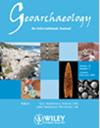Diversification of lithic raw materials used by Mesolithic inhabitants of Los Canes cave (Sierra del Cuera, Eastern Asturias, Spain), and quartz crystallite size of chert as an essential indicator parameter of its provenance
IF 1.4
3区 地球科学
0 ARCHAEOLOGY
引用次数: 1
Abstract
Two types of studies were carried out on the lithic materials found in stratigraphic unit 6 of Los Canes cave used by Mesolithic human groups: (1) quantification of the retouched and nonretouched lithic materials to determine the adaptive strategy in relation to changes in the availability and technology resources and (2) crystallographic/mineralogical characterization of the nonretouched lithic materials using the RGB (R being red, G green, and B blue) code for color, transmission polarization optical microscopy, X‐ray diffraction, X‐ray fluorescence, infrared and Raman spectroscopies, and total organic carbon analyses. Cluster and factorial statistical analyses were performed to establish the relationship between samples. The main conclusions extracted are as follows: (1) The mobility of the inhabitants of Los Canes cave may have been very restricted, and they used local raw materials. (2) The inhabitants of Los Canes cave used chert preferentially in the elaboration of different typologies. (3) The mineralogical and elemental compositions of the chert samples from Level 6 of Los Canes cave and those from nearby outcrops are similar. (4) The crystallite size values of the tool cherts (>1000 Å) and the almost complete absence of moganite and chalcedony indicate a high degree of maturity and could belong to the Carboniferous, the period to which the cherts of the outcrops used for comparison also belong.Los Canes洞穴(Sierra del Cuera,东阿斯图里亚斯,西班牙)中石器时代居民使用的岩屑原料的多样化,以及燧石的石英晶体大小作为其物源的重要指示参数
对在Los Canes洞穴地层单元6中发现的中石器时代人类群体使用的石器材料进行了两种类型的研究:(1)对修饰和未修饰的岩屑材料进行量化,以确定与可用性和技术资源变化相关的适应策略;(2)使用RGB (R为红色,G为绿色,B为蓝色)颜色编码、透射偏振光学显微镜、X射线衍射、X射线荧光、红外和拉曼光谱以及总有机碳分析对未修饰的岩屑材料进行晶体学/矿物学表征。进行聚类和析因统计分析以建立样本之间的关系。得出的主要结论如下:(1)Los Canes洞穴居民的流动性可能非常有限,他们使用当地的原材料。(2) Los Canes洞穴的居民在阐述不同的类型学时优先使用燧石。(3) Los Canes洞穴6层燧石样品的矿物学和元素组成与附近露头燧石样品相似。(4)工具燧石(>1000 Å)的结晶尺寸值和几乎完全没有莫干石和玉髓,表明成熟度高,可能属于石炭纪,用于比较的露头燧石也属于石炭纪。
本文章由计算机程序翻译,如有差异,请以英文原文为准。
求助全文
约1分钟内获得全文
求助全文
来源期刊

Geoarchaeology-An International Journal
地学-地球科学综合
CiteScore
3.60
自引率
5.90%
发文量
51
审稿时长
>12 weeks
期刊介绍:
Geoarchaeology is an interdisciplinary journal published six times per year (in January, March, May, July, September and November). It presents the results of original research at the methodological and theoretical interface between archaeology and the geosciences and includes within its scope: interdisciplinary work focusing on understanding archaeological sites, their environmental context, and particularly site formation processes and how the analysis of sedimentary records can enhance our understanding of human activity in Quaternary environments. Manuscripts should examine the interrelationship between archaeology and the various disciplines within Quaternary science and the Earth Sciences more generally, including, for example: geology, geography, geomorphology, pedology, climatology, oceanography, geochemistry, geochronology, and geophysics. We also welcome papers that deal with the biological record of past human activity through the analysis of faunal and botanical remains and palaeoecological reconstructions that shed light on past human-environment interactions. The journal also welcomes manuscripts concerning the examination and geological context of human fossil remains as well as papers that employ analytical techniques to advance understanding of the composition and origin or material culture such as, for example, ceramics, metals, lithics, building stones, plasters, and cements. Such composition and provenance studies should be strongly grounded in their geological context through, for example, the systematic analysis of potential source materials.
 求助内容:
求助内容: 应助结果提醒方式:
应助结果提醒方式:


